Report: BMW's Sustainable Development and Business Analysis
VerifiedAdded on 2021/04/21
|5
|1046
|110
Report
AI Summary
This report provides an analysis of BMW's sustainable development strategies, highlighting their commitment to environmental sustainability and business practices. BMW's approach includes reducing CO2 emissions, focusing on electric vehicles, and implementing circular economy principles. The company's initiatives encompass the development of electric vehicles, such as the BMW i3, and the adoption of innovative technologies like the GINA concept. BMW emphasizes resource efficiency through the use of lighter materials and the integration of renewable energy sources in its production processes. Furthermore, the report discusses BMW's dedication to worker health, non-discriminatory practices, and sustainable transport. Overall, the report showcases BMW's holistic approach to sustainable development by integrating environmental and social considerations into its business model, including waste management and job creation.
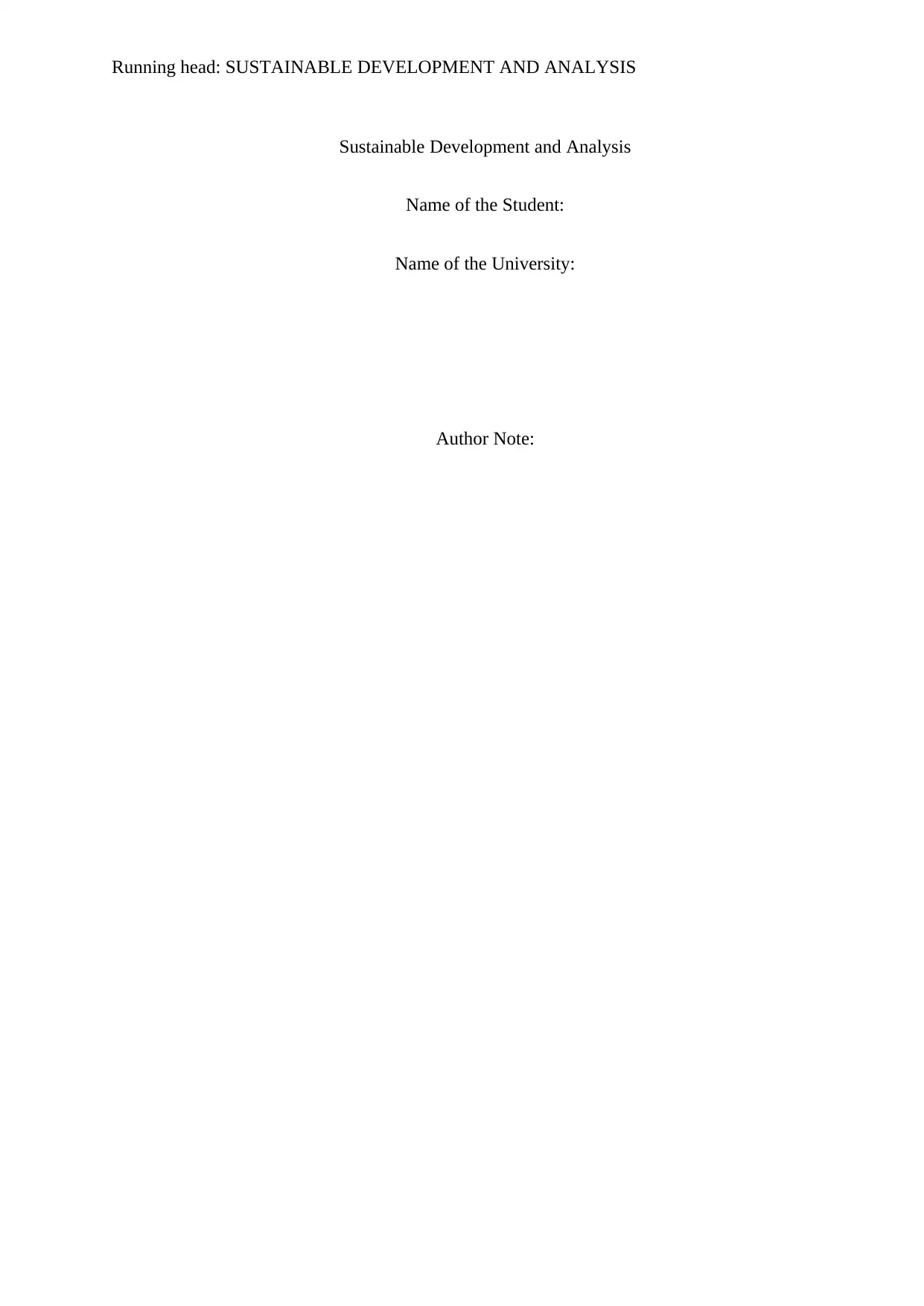
Running head: SUSTAINABLE DEVELOPMENT AND ANALYSIS
Sustainable Development and Analysis
Name of the Student:
Name of the University:
Author Note:
Sustainable Development and Analysis
Name of the Student:
Name of the University:
Author Note:
Paraphrase This Document
Need a fresh take? Get an instant paraphrase of this document with our AI Paraphraser
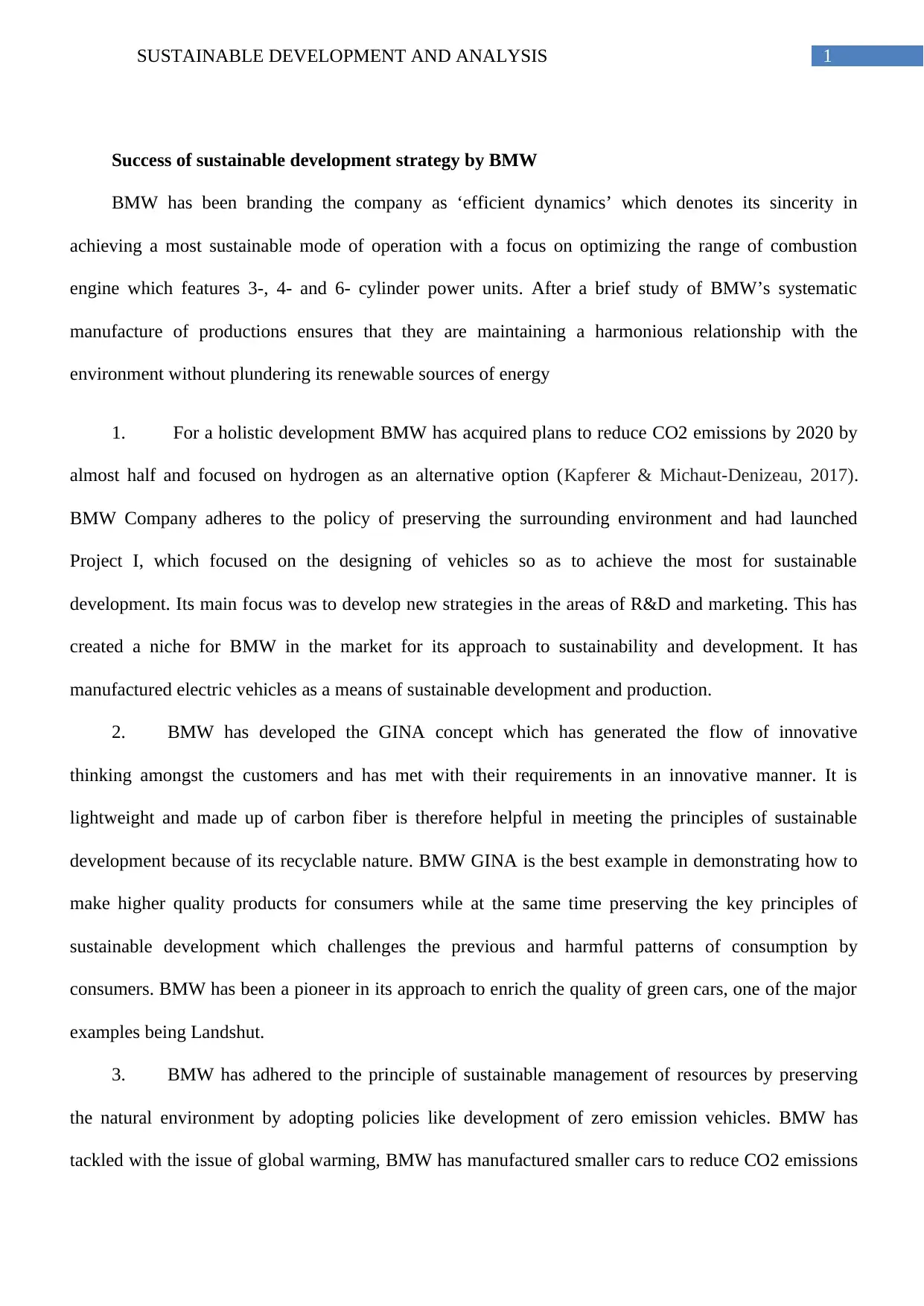
1SUSTAINABLE DEVELOPMENT AND ANALYSIS
Success of sustainable development strategy by BMW
BMW has been branding the company as ‘efficient dynamics’ which denotes its sincerity in
achieving a most sustainable mode of operation with a focus on optimizing the range of combustion
engine which features 3-, 4- and 6- cylinder power units. After a brief study of BMW’s systematic
manufacture of productions ensures that they are maintaining a harmonious relationship with the
environment without plundering its renewable sources of energy
1. For a holistic development BMW has acquired plans to reduce CO2 emissions by 2020 by
almost half and focused on hydrogen as an alternative option (Kapferer & Michaut-Denizeau, 2017).
BMW Company adheres to the policy of preserving the surrounding environment and had launched
Project I, which focused on the designing of vehicles so as to achieve the most for sustainable
development. Its main focus was to develop new strategies in the areas of R&D and marketing. This has
created a niche for BMW in the market for its approach to sustainability and development. It has
manufactured electric vehicles as a means of sustainable development and production.
2. BMW has developed the GINA concept which has generated the flow of innovative
thinking amongst the customers and has met with their requirements in an innovative manner. It is
lightweight and made up of carbon fiber is therefore helpful in meeting the principles of sustainable
development because of its recyclable nature. BMW GINA is the best example in demonstrating how to
make higher quality products for consumers while at the same time preserving the key principles of
sustainable development which challenges the previous and harmful patterns of consumption by
consumers. BMW has been a pioneer in its approach to enrich the quality of green cars, one of the major
examples being Landshut.
3. BMW has adhered to the principle of sustainable management of resources by preserving
the natural environment by adopting policies like development of zero emission vehicles. BMW has
tackled with the issue of global warming, BMW has manufactured smaller cars to reduce CO2 emissions
Success of sustainable development strategy by BMW
BMW has been branding the company as ‘efficient dynamics’ which denotes its sincerity in
achieving a most sustainable mode of operation with a focus on optimizing the range of combustion
engine which features 3-, 4- and 6- cylinder power units. After a brief study of BMW’s systematic
manufacture of productions ensures that they are maintaining a harmonious relationship with the
environment without plundering its renewable sources of energy
1. For a holistic development BMW has acquired plans to reduce CO2 emissions by 2020 by
almost half and focused on hydrogen as an alternative option (Kapferer & Michaut-Denizeau, 2017).
BMW Company adheres to the policy of preserving the surrounding environment and had launched
Project I, which focused on the designing of vehicles so as to achieve the most for sustainable
development. Its main focus was to develop new strategies in the areas of R&D and marketing. This has
created a niche for BMW in the market for its approach to sustainability and development. It has
manufactured electric vehicles as a means of sustainable development and production.
2. BMW has developed the GINA concept which has generated the flow of innovative
thinking amongst the customers and has met with their requirements in an innovative manner. It is
lightweight and made up of carbon fiber is therefore helpful in meeting the principles of sustainable
development because of its recyclable nature. BMW GINA is the best example in demonstrating how to
make higher quality products for consumers while at the same time preserving the key principles of
sustainable development which challenges the previous and harmful patterns of consumption by
consumers. BMW has been a pioneer in its approach to enrich the quality of green cars, one of the major
examples being Landshut.
3. BMW has adhered to the principle of sustainable management of resources by preserving
the natural environment by adopting policies like development of zero emission vehicles. BMW has
tackled with the issue of global warming, BMW has manufactured smaller cars to reduce CO2 emissions
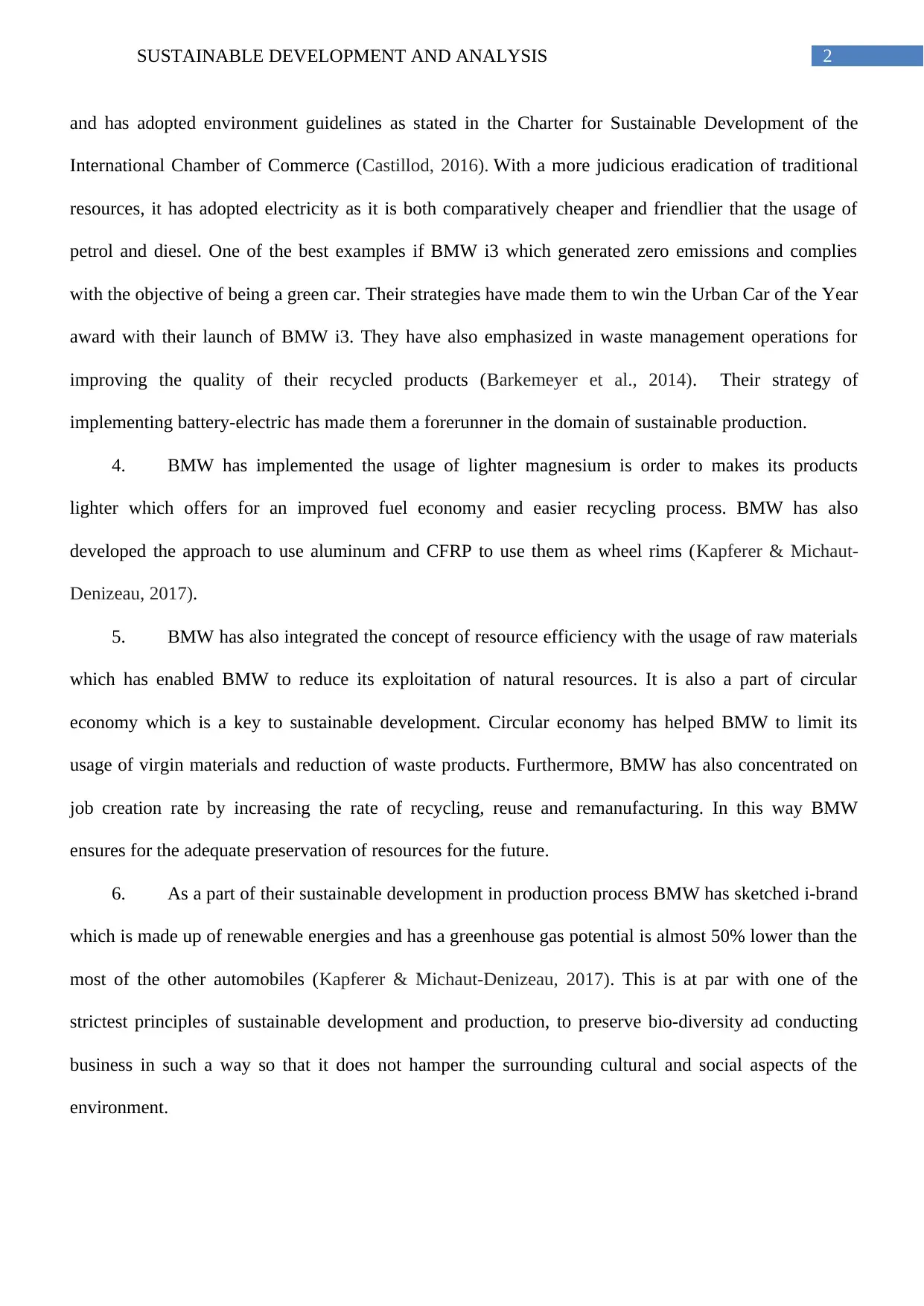
2SUSTAINABLE DEVELOPMENT AND ANALYSIS
and has adopted environment guidelines as stated in the Charter for Sustainable Development of the
International Chamber of Commerce (Castillod, 2016). With a more judicious eradication of traditional
resources, it has adopted electricity as it is both comparatively cheaper and friendlier that the usage of
petrol and diesel. One of the best examples if BMW i3 which generated zero emissions and complies
with the objective of being a green car. Their strategies have made them to win the Urban Car of the Year
award with their launch of BMW i3. They have also emphasized in waste management operations for
improving the quality of their recycled products (Barkemeyer et al., 2014). Their strategy of
implementing battery-electric has made them a forerunner in the domain of sustainable production.
4. BMW has implemented the usage of lighter magnesium is order to makes its products
lighter which offers for an improved fuel economy and easier recycling process. BMW has also
developed the approach to use aluminum and CFRP to use them as wheel rims (Kapferer & Michaut-
Denizeau, 2017).
5. BMW has also integrated the concept of resource efficiency with the usage of raw materials
which has enabled BMW to reduce its exploitation of natural resources. It is also a part of circular
economy which is a key to sustainable development. Circular economy has helped BMW to limit its
usage of virgin materials and reduction of waste products. Furthermore, BMW has also concentrated on
job creation rate by increasing the rate of recycling, reuse and remanufacturing. In this way BMW
ensures for the adequate preservation of resources for the future.
6. As a part of their sustainable development in production process BMW has sketched i-brand
which is made up of renewable energies and has a greenhouse gas potential is almost 50% lower than the
most of the other automobiles (Kapferer & Michaut-Denizeau, 2017). This is at par with one of the
strictest principles of sustainable development and production, to preserve bio-diversity ad conducting
business in such a way so that it does not hamper the surrounding cultural and social aspects of the
environment.
and has adopted environment guidelines as stated in the Charter for Sustainable Development of the
International Chamber of Commerce (Castillod, 2016). With a more judicious eradication of traditional
resources, it has adopted electricity as it is both comparatively cheaper and friendlier that the usage of
petrol and diesel. One of the best examples if BMW i3 which generated zero emissions and complies
with the objective of being a green car. Their strategies have made them to win the Urban Car of the Year
award with their launch of BMW i3. They have also emphasized in waste management operations for
improving the quality of their recycled products (Barkemeyer et al., 2014). Their strategy of
implementing battery-electric has made them a forerunner in the domain of sustainable production.
4. BMW has implemented the usage of lighter magnesium is order to makes its products
lighter which offers for an improved fuel economy and easier recycling process. BMW has also
developed the approach to use aluminum and CFRP to use them as wheel rims (Kapferer & Michaut-
Denizeau, 2017).
5. BMW has also integrated the concept of resource efficiency with the usage of raw materials
which has enabled BMW to reduce its exploitation of natural resources. It is also a part of circular
economy which is a key to sustainable development. Circular economy has helped BMW to limit its
usage of virgin materials and reduction of waste products. Furthermore, BMW has also concentrated on
job creation rate by increasing the rate of recycling, reuse and remanufacturing. In this way BMW
ensures for the adequate preservation of resources for the future.
6. As a part of their sustainable development in production process BMW has sketched i-brand
which is made up of renewable energies and has a greenhouse gas potential is almost 50% lower than the
most of the other automobiles (Kapferer & Michaut-Denizeau, 2017). This is at par with one of the
strictest principles of sustainable development and production, to preserve bio-diversity ad conducting
business in such a way so that it does not hamper the surrounding cultural and social aspects of the
environment.
⊘ This is a preview!⊘
Do you want full access?
Subscribe today to unlock all pages.

Trusted by 1+ million students worldwide
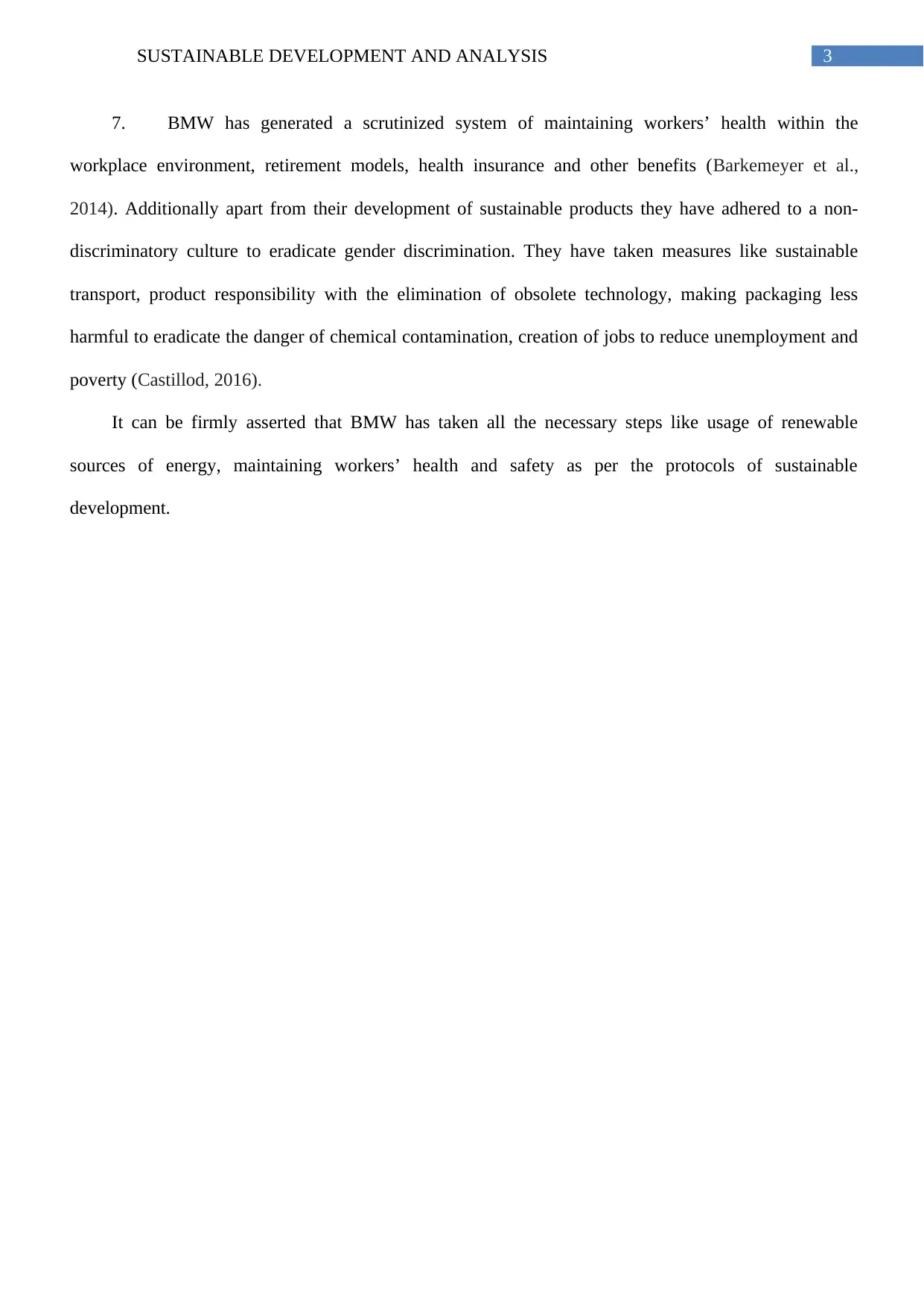
3SUSTAINABLE DEVELOPMENT AND ANALYSIS
7. BMW has generated a scrutinized system of maintaining workers’ health within the
workplace environment, retirement models, health insurance and other benefits (Barkemeyer et al.,
2014). Additionally apart from their development of sustainable products they have adhered to a non-
discriminatory culture to eradicate gender discrimination. They have taken measures like sustainable
transport, product responsibility with the elimination of obsolete technology, making packaging less
harmful to eradicate the danger of chemical contamination, creation of jobs to reduce unemployment and
poverty (Castillod, 2016).
It can be firmly asserted that BMW has taken all the necessary steps like usage of renewable
sources of energy, maintaining workers’ health and safety as per the protocols of sustainable
development.
7. BMW has generated a scrutinized system of maintaining workers’ health within the
workplace environment, retirement models, health insurance and other benefits (Barkemeyer et al.,
2014). Additionally apart from their development of sustainable products they have adhered to a non-
discriminatory culture to eradicate gender discrimination. They have taken measures like sustainable
transport, product responsibility with the elimination of obsolete technology, making packaging less
harmful to eradicate the danger of chemical contamination, creation of jobs to reduce unemployment and
poverty (Castillod, 2016).
It can be firmly asserted that BMW has taken all the necessary steps like usage of renewable
sources of energy, maintaining workers’ health and safety as per the protocols of sustainable
development.
Paraphrase This Document
Need a fresh take? Get an instant paraphrase of this document with our AI Paraphraser
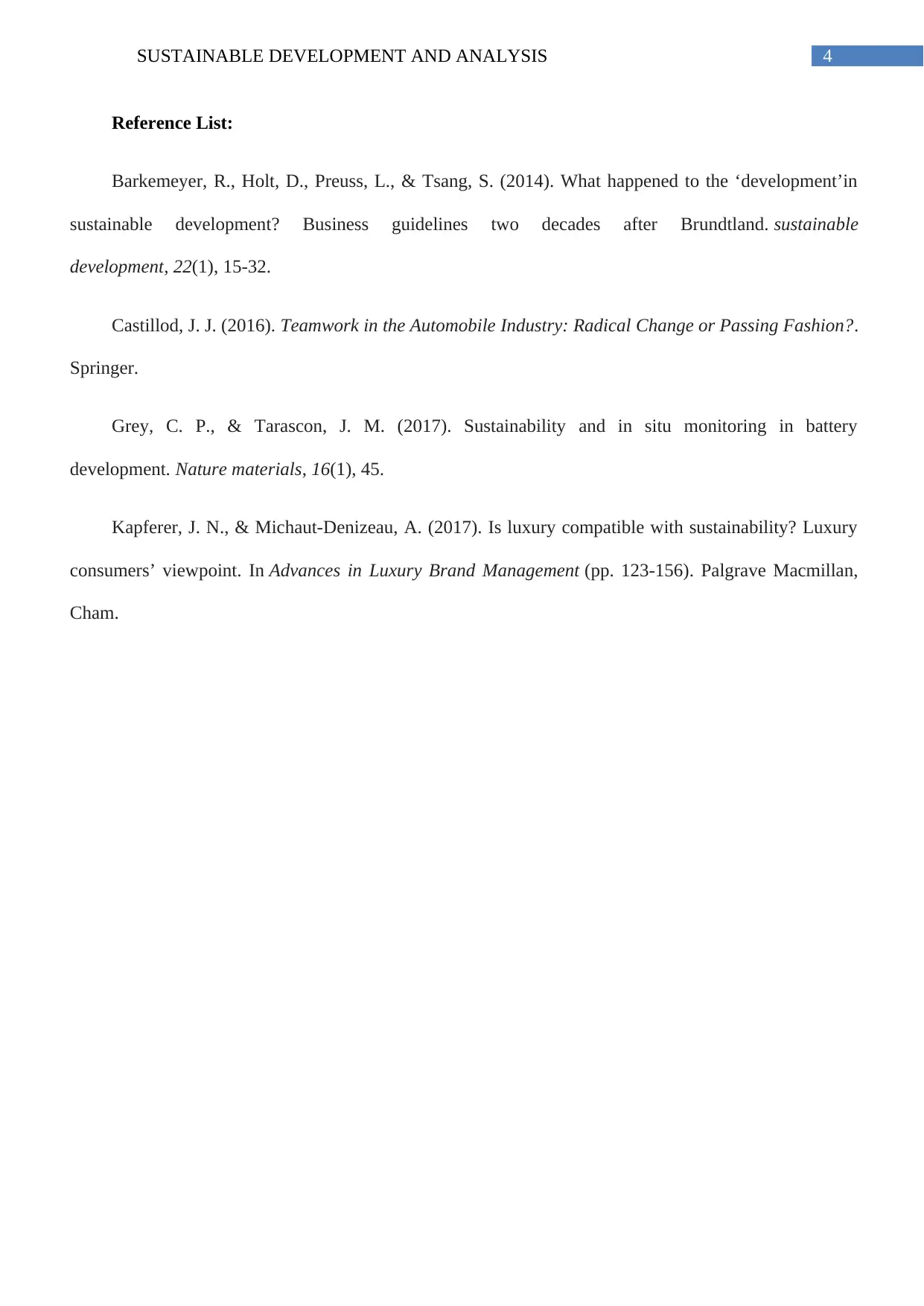
4SUSTAINABLE DEVELOPMENT AND ANALYSIS
Reference List:
Barkemeyer, R., Holt, D., Preuss, L., & Tsang, S. (2014). What happened to the ‘development’in
sustainable development? Business guidelines two decades after Brundtland. sustainable
development, 22(1), 15-32.
Castillod, J. J. (2016). Teamwork in the Automobile Industry: Radical Change or Passing Fashion?.
Springer.
Grey, C. P., & Tarascon, J. M. (2017). Sustainability and in situ monitoring in battery
development. Nature materials, 16(1), 45.
Kapferer, J. N., & Michaut-Denizeau, A. (2017). Is luxury compatible with sustainability? Luxury
consumers’ viewpoint. In Advances in Luxury Brand Management (pp. 123-156). Palgrave Macmillan,
Cham.
Reference List:
Barkemeyer, R., Holt, D., Preuss, L., & Tsang, S. (2014). What happened to the ‘development’in
sustainable development? Business guidelines two decades after Brundtland. sustainable
development, 22(1), 15-32.
Castillod, J. J. (2016). Teamwork in the Automobile Industry: Radical Change or Passing Fashion?.
Springer.
Grey, C. P., & Tarascon, J. M. (2017). Sustainability and in situ monitoring in battery
development. Nature materials, 16(1), 45.
Kapferer, J. N., & Michaut-Denizeau, A. (2017). Is luxury compatible with sustainability? Luxury
consumers’ viewpoint. In Advances in Luxury Brand Management (pp. 123-156). Palgrave Macmillan,
Cham.
1 out of 5
Related Documents
Your All-in-One AI-Powered Toolkit for Academic Success.
+13062052269
info@desklib.com
Available 24*7 on WhatsApp / Email
![[object Object]](/_next/static/media/star-bottom.7253800d.svg)
Unlock your academic potential
Copyright © 2020–2025 A2Z Services. All Rights Reserved. Developed and managed by ZUCOL.





